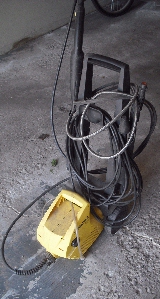 |
| A power washer is excellent for removing loose material and most stains. |
|
| Baking soda. Wet oil stain. Apply liberally. Let sit. Scrub and rinse with water. |
|
| Use full strength on areas no larger than 12"x12" (30x30 mm). Let it soak in for a few minutes. Scrub and rinse with water. |
|
| Painting the Garage Floor |
|
|
Painting your garage floor with epoxy paint will provide a tough finish. Any stains, including oil spills can be cleaned up easy.,
Painted cement floors have a tendency to peel after a while. Proper cleaning and priming will make the paint job last longer.
- Provide adequate ventilation.
- Remove all stains and clean thoroughly.
- Fill in cracks and etch if necessary.
- Apply primer and finish coat(s).
- Links to other helpful articles.
GOOD VENTILATION OF THE WORK AREA IS A MUST!
Cleaning products, etching solutions and the epoxy paint itself all produce harmful vapors. Always protect yourself, wear rubber gloves and eye protection. Ventilation can be provided by fans or opening windows and/or garage door.
CLEAN THE FLOOR THOROUGHLY, REMOVE ALL STAINS
Start with sweeping the floor to remove most of the loose dirt follow with a thorough cleaning. Oil or others stains can be removed by any of the following methods:
1- Bleach and water. Mix three parts of water and one part of bleach. Apply mixture to the stain and let is sit for a few minutes then give it a good scrub with a stiff bristle brush. Rinse the treated spot well with clean water. Don't forget to rubber gloves and eye protection.
2- Baking soda. Wet the oil stain. Apply baking soda liberally. Let it sit for a while. Scrub with a stiff bristle brush and rinse with water. Repeat if necessary.
3- CLR (Calcium, Lime, Rust) Grease Magnet. Apply full strenth. Pour on stains and let it sit for a few minutes. Scrub with a stiff bristle brush and rinse with water.
4- TSP is another well known product for removing stains from cement floors.
5- Stains can also be removed by using a pressure or power washer. Since you are only using water, you may as well clean the entire garage floor. The power washer will also remove any loose material stuck in small cracks and loose particles from older cement floors.
FILL IN LARGE CRACKS AND ETCH IF NECCESSARY
CRACK REPAIR
Use a concrete-mortar compound to repair cracks in the garage floor. Just make sure that all loose material has been washed away and that the crack is completely dry.
In my own garage I filled in a large crack with leftover interior caulking. Since the crack was large (up to 1/2" - 13 mm wide) I applied the caulking in two stages. First I laid the foundation and let it dry for a few days before filling in the crack completely. What I like about the caulking method is that the filler is flexible and will not crack again like concrete products.
ETCHING
Not all garage floors need etching. To find out, pour some water on the floor. If it absorbs quickly into the concrete, etching will not be required. Newer poured concrete garage floors have a more dense surface and may not readily absorb water and etching will be required. Etching will pit or open the concrete surface so that the paint will adhere better.
Option 1: You can use an etching cleaner or a one part muriatic acid to ten parts water solution. These products will release potential harmful vapors so ventilate the working area and wear rubber gloves and eye protection.
Option 2: Add two cups of white vinegar to a gallon of water. This solution works almost as well as muriatic acid and does not produce potential harmful vapors.
Do not apply a primer till the floor is completely dry. Wait a day or two.
|
|
|
APPLY A PRIMER AND FINISH COAT(s)
PRIMER
Applying a primer before painting is akin to laying the foundation before building a house. You can't do without either one. The primer provides a good surface for the paint to adhere to and prevents premature peeling.
A good primer coat is the key to a long-lasting paint job. Some claim that white vinegar is a good primer for concrete garage floors but I have never used vinegar as a primer.
FINISH COAT
When the primed floor is dry (8-12 hours) you can apply the finish coat of epoxy paint. It is better to use two thin coats than one heavy one. Wait about 24 hours before applying the second coat.
- Use nylon brushes and,
- Do not walk on the newly painted floor for 24 hours.
- Do not drive on the newly painted floor for a week.
LINKS TO OTHER HELPFUL ARTICLES
Tools and supplies. For surface preparation and painting.
Buy the right brush or roller. Bristles, roller material, nap length.
Surface preparation. Wallpaper glue. Treating mildew.
Liquid sandpaper - deglossers. What it is. What it doesn't do.
Painting tips. Getting ready. Tools. Painting. Storing paint.
Paint Tray Liners. Make your own. Do you really need one?
Clean-up time. Brushes, rollers, trays, solvents, paint disposal.
Lead in paint. Health warning. Remedial action. Government.
Lead. Sources of lead other than paint. Remedial actions. Health concerns. |
|
|
|
|
Back to Top |
|